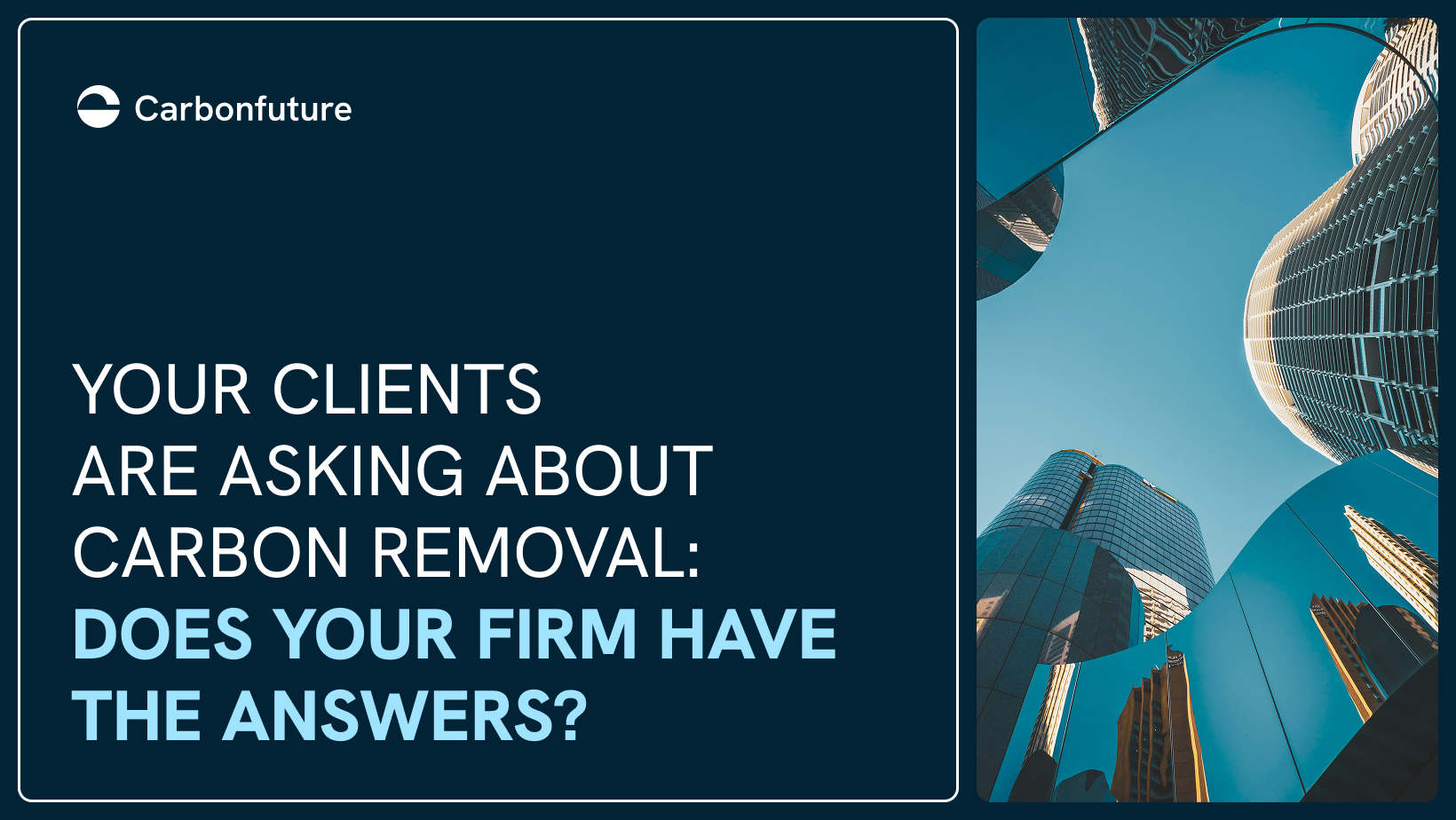Professional services firms—consultancies, auditors, law firms, and advisors—don’t just advise clients. They shape industries and influence decisions at scale. That makes them powerful multipliers in the race to net zero.
Here are 5 ways professional services firms can lead on durable carbon removal (CDR):
1. Embed Carbon Removal into Client Advisory
Whether advising on sustainability strategy, risk, or compliance, guide clients toward credible removals and position yourself as a trusted expert.
- Bridge knowledge gaps on high-quality, durable carbon removal vs. traditional offsets. “Carbon removal helps tackle the root cause of climate change: excess carbon dioxide in the atmosphere. Unlike avoidance measures or short-lived offsets, durable carbon removal credits are designed to store carbon securely for centuries and are increasingly seen as an essential part of credible Net Zero strategies,” explains a Senior Consultant at Q5.
- Strengthen client credibility by focusing on high-quality removals — as BCG highlights, “the credibility of net zero targets increasingly depends on durable carbon removal” — a signal that leading firms are already integrating removals into 2030 roadmaps.
2. Procure Carbon Removal to Offset Operational Emissions
Lead by example where it counts. Firms may have relatively small footprints, but their visibility is high. By investing in durable carbon removal, they enhance ESG credibility.
- Balance your footprint with high-quality, audit-ready credits
- Show integrity by acting before regulations demand it — BCG emphasizes that companies who integrate durable removals early will gain “a stronger license to operate” with regulators and stakeholders
- Secure early access to limited, durable CDR supply
As a Senior Consultant at Q5 explains: “Although professional services firms typically have smaller carbon footprints, our visibility with clients and stakeholders gives us significant influence. This creates both an opportunity and a responsibility to lead by example, showing that ambitious action on carbon removal is both possible and necessary. Even for smaller emitters like Q5, progress still matters. Clients and stakeholders expect their partners to decarbonize, and full supply chain participation is essential for the success of Net Zero.”
3. Launch Employee Engagement Campaigns
Turn carbon removal into a story employees can rally around. Use CDR projects in storytelling to inspire employees, integrate removals into internal sustainability challenges, and boost retention and brand pride.
- Highlight tangible projects and their co-benefits
- Turn climate action into a culture-building initiative
- Position the firm as an employer of choice for purpose-driven talent. In Deloitte’s 2024 Gen Z and Millennial Survey, 55% of Gen Zs and 54% of millennials say they research a company’s environmental impact and policies before accepting a job — meaning climate credibility now directly affects your ability to hire and retain top talent. And according to Capgemini, 68% of young people are worried they don’t have the green skills needed to act on climate change. Linking your firm’s climate initiatives to professional development can directly address this gap.
4. Support Industry Standards and Policy Development
Lend your expertise in verification frameworks, disclosure standards, and governance to shape the rules while showcasing thought leadership.
- Influence the credibility of emerging standards and Monitoring, Reporting, and Verification (MRV) frameworks
- Build recognition as a trusted voice on net zero and ESG compliance
- Guide clients confidently through an evolving policy landscape
5. Act as Multipliers Through Client Channels
Amplify impact through every client you serve by integrating CDR into sustainability reporting, risk management, and advisory work—expanding awareness and adoption across entire industries.
- Normalize removals across industries and sectors
- Leverage client-facing deliverables to expand CDR adoption
- Create multiplier effects that drive systemic impact
Why This Matters
Durable carbon removal is essential to closing the gap to net zero. Professional services firms have a unique multiplier effect:
- By embedding CDR into client advisory, they influence sustainability strategies across industries.
- By procuring removals, they can walk the talk and build ESG credibility.
- Through employee engagement, they turn climate action into a cultural advantage.
- By supporting industry standards and policy development, they help shape credible global frameworks.
- By acting as multipliers, they amplify adoption across entire client networks.
Firms that lead today won’t just future-proof their business—they’ll accelerate adoption across entire industries.
Ready to turn carbon removal into a competitive edge for your clients and your firm? Talk to our experts today and lead the way to net zero.
FAQ
What is Carbon Dioxide Removal (CDR)?
Carbon Dioxide Removal (CDR) refers to human-led efforts to remove CO₂ from the atmosphere and store it permanently, preventing it from re-entering the atmosphere and contributing to climate change. Durable CDR methods store carbon for hundreds to thousands of years in geological formations, soils, oceans, or long-lived materials.
How is carbon removal different from carbon reduction or carbon avoidance?
- Carbon reduction lowers emissions at the source (e.g., switching to renewable energy, electrifying fleets).
- Carbon avoidance prevents emissions from being released elsewhere (e.g., protecting forests, funding clean cookstoves).
- Carbon removal goes further by permanently taking existing CO₂ out of the atmosphere — making it essential for balancing hard-to-abate emissions and achieving net-negative pathways.
Why should professional firms invest in carbon removal?
They act as multipliers, influencing entire industries. By adopting CDR early, firms strengthen ESG credibility and help normalize removals across sectors.
